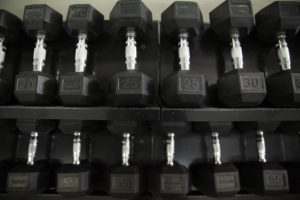While having a gym to train at has advantages over training at home – generally a greater equipment selection, for example, and if you’re booked for sessions with a coach it tends to be easier to follow through on the commitment. But at the same time, there are some additional challenges – going to the gym itself adds travel time on and other obligations (work, family, etc) can pop up and mean an appointment must be missed.
With all of this in mind, if you have the resources and can allocate a bit of space, outfitting yourself with a “home gym” is a fantastic idea. And while doing a Crossfit-style mini-box in your garage with rigs, barbells, rowers, and kettlebells is awesome, it demands quite a bit more space (and expense) than many folks have.
But fear not! True North is here with some recommendations on how to build the ideal “minimalist” home gym!

To start things off, look at your space. How much do you have? If you can’t allocate about 100ft² (because you live in a one-bedroom apartment and justifiably can’t/won’t sacrifice living room space for fitness equipment) then you’re a little more limited… but still not entirely out of luck. Realistically, while you’re not going to be able to build your strength past a certain (relative) point, it is still of value to get as strong as you’re able to with the resources available.
So: space dictates equipment. If you have a very small amount of room (ie. the one-bedroom apartment mentioned above, for example) then you need something that can be stored easily and has a minimal footprint when it’s out. In this scenario, consider investing in:
- A yoga mat and a stability/Swiss ball: $40-$80

- A suspension training system that can be anchored in a sturdy door frame (we recommend either the TRX or if you want something more portable, the Monkii bars): $180 to $250, depending on which way you go.
- A sandbag that allows a varying amount of weight: $150 to $200, depending on the minimum/maximum amount of weight you’d like to be able to access
- Total Investment: $370 to $530
If you have more space (outdoors on a patio, for example), don’t care about equipment in the living room, or (best-case scenario) have a spare room or garage that you can dedicate to the training space, then the following items give you a very, very well-equipped home training space (note – these are listed in order of recommended purchase if you aren’t able to spend the entire amount at once):
- A yoga mat and a stability/Swiss ball: $40-$80
- Suspension Training System with mount (door or ceiling): $180 to $250
- A sandbag that allows for varying weight: $150 to $200

- Kettlebells 8/10/12kg for women, 12/16/20kg for men – as a rough starting weight): $100 to $200 for sets of 3, depending on the weight combination you choose)
- Superbands (full loops, not the bands with handles on the end): $50 to $80
- A wooden box with three different heights that can be used for loaded step-ups (but NOT jumping): $120 to $160
- A bench – preferably one that can be adjusted for incline: $125 to $200
- Dumbbells – probably best to look at the adjustable ones, like the Power Blocks or Bowflex Selectech: $600 to $700, for sets that are adjustable from 10lbs to 50lbs
- Total Investment: $1365 to $1870
And there’s your home gym!
Just a few final notes about set up. First of all, if the cost (especially for the fully kitted gym) seems high, remember that a) most of it is a one-time expense, and b) you don’t need to do it all at once. You also may elect to skip the kettlebell options, and just stick with the sandbags… which isn’t a bad idea if you’re not able/interested in learning exactly how to use the kettlebells. The sandbags won’t damage the floor (or you) if they’re dropped, and the learning curve is a lot more forgiving. HOWEVER: almost everything you can do with a dumbbell you can do with a kettlebell – so another option would be to skip the dumbbells and just buy pairs for the kettlebells (or heavier kettlebells). Lastly – be careful with used equipment or buying online from a non-fitness related store (i.e. Amazon). Used equipment like a dumbbell or flat bench should be fine, but once you start getting into things like a TRX or worse, cardio equipment, you have no recourse if something goes wrong or breaks. And there are A LOT of knock-offs available online along with legitimate pieces – so if you’re going to buy from there, avoid anything that is absurdly cheap in comparison.
Ultimately, even if you have a gym that you go to or access regularly, having some of the key pieces listed above can be very helpful for those times that school concerts, birthday parties or unexpected pandemics pop up. You may not use them daily, but having it around makes it a lot easier to hold yourself accountable and stay on task.
Let us know if you have any questions about where to find some of this, or about brand names and quality.
Until next time, keep fit and have fun.


